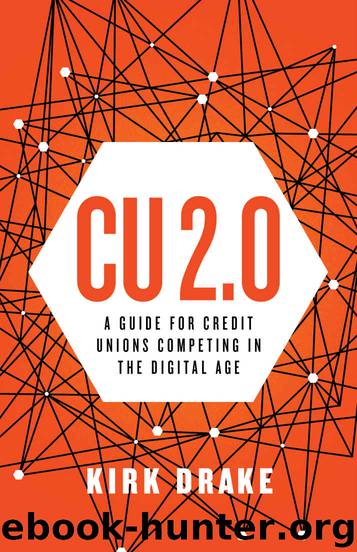CU 2.0: A Guide for Credit Unions Competing in the Digital Age by Kirk Drake

Author:Kirk Drake [Drake, Kirk]
Language: eng
Format: epub
Publisher: Lioncrest Publishing
Published: 2017-06-20T04:00:00+00:00
You should be able to do all of this in one to two hours. After the initial set-up, invest one hour per week moving forward to constantly engage your members.
Chapter 10
10. Survey
Many credit unions validate their service with Net Promoter tools, and while I think Net Promoter is a good start, it’s not a comprehensive tool. Yes, in theory, if a member is willing to refer you, that’s a great indication of your services and the member’s loyalty, but it neglects all the members who never get to that stage. Creating a repetitive process that allows you to continuously adjust and recreate good experiences for your employees is essential for receiving social validation.
Let me give you an example. I fly a lot, and every time I fly, I receive a survey from United asking how likely am I to refer the airline company to someone else. I might answer I’m likely to do so, because it was a good experience, but it doesn’t address the real question of, “Do I ever refer airlines to someone else?” The reality is, I don’t care how good my one individual flight experience was with United. On a collective level, the airline is so commoditized that it’s a stupid question—and it certainly won’t change my behavior. It doesn’t encourage me to refer business, nor does it reflect my loyalty to the airline.
Credit unions have lots of repeated interactions—swiping a credit card, going to an ATM, calling a call center, etc. Since financial services are commoditized and fungible, it’s not fair to measure loyalty on a transactional level; you have to look at it much more holistically. Loyalty comes from the way you make a member feel, among other intangible identifiers. Feelings come from experiences that are unexpected or highly differentiated. The brain is specifically designed to forget all the routine stuff.
Here is a quick test. Close your eyes and think about your childhood. After about a minute, what are the top three memories (good or bad) that immediately pop into your head? Most likely, they won’t be routine stuff like brushing your teeth or mom making dinner. It might be dad making you dinner, though, because that might have occurred less regularly (no gender stereotypes intended). Either way, your brain is tuned to ignore basic day-to-day stuff over time and filter it out.
Tools like LiveSurvey are a great way to see a holistic picture. You’re able to map the person at an intricate level when giving the service, the resolution to the problem on a one-on-one basis, etc. If something along the line isn’t going well, you are privy to enough data to step in and fix it in near real time. LiveSurvey tracks each transaction and follows up with the member to solicit feedback. Every time a member calls the call center or walks into a branch, within a minute or two of that transaction, LiveSurvey is notified of the transaction within the system. It knows what, where, and who made the transaction and can immediately send a survey to ask valid experiential questions related to the transaction.
Download
This site does not store any files on its server. We only index and link to content provided by other sites. Please contact the content providers to delete copyright contents if any and email us, we'll remove relevant links or contents immediately.
International Integration of the Brazilian Economy by Elias C. Grivoyannis(91225)
The Radium Girls by Kate Moore(11921)
Turbulence by E. J. Noyes(7936)
Nudge - Improving Decisions about Health, Wealth, and Happiness by Thaler Sunstein(7615)
The Black Swan by Nassim Nicholas Taleb(7010)
Rich Dad Poor Dad by Robert T. Kiyosaki(6403)
Pioneering Portfolio Management by David F. Swensen(6226)
Man-made Catastrophes and Risk Information Concealment by Dmitry Chernov & Didier Sornette(5921)
Zero to One by Peter Thiel(5686)
Secrecy World by Jake Bernstein(4646)
Millionaire: The Philanderer, Gambler, and Duelist Who Invented Modern Finance by Janet Gleeson(4376)
The Age of Surveillance Capitalism by Shoshana Zuboff(4210)
Skin in the Game by Nassim Nicholas Taleb(4162)
Bullshit Jobs by David Graeber(4095)
The Money Culture by Michael Lewis(4076)
Skin in the Game: Hidden Asymmetries in Daily Life by Nassim Nicholas Taleb(3929)
The Dhandho Investor by Mohnish Pabrai(3699)
The Wisdom of Finance by Mihir Desai(3654)
Blockchain Basics by Daniel Drescher(3507)
